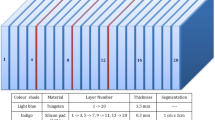Abstract
Purpose
The high-energy cosmic radiation detection (HERD) is a dedicated space cosmic ray detector, planned to be launched and installed on the China Space Station (CSS) around 2027. One of the main goals of HERD is to measure the composition and energy spectra of cosmic rays (CR) with energies as high as several PeV by using silicon charge detectors (SCD) (Altomare et al. in The silicon charge detector of the high energy cosmic radiation detection facility, 2023), plastic scintillator detectors (PSD) (Kyratzis et al. in Proceedings of Sc. (ICRC2021), vol. 651, 2021), and 3D calorimeters (CALO) (Liu et al. in J Instrum 18(09):09002, 2023). To assess HERD’s charge measurement capability during the beam test, a particle identification detector (PID) with a large dynamic range is required.
Methods
A Si-PIN-based PID detector is conceptualized and manufactured. It is composed of four layers, each containing 30 Si-PIN sensors. In four IDE1160 ASICs, the signals from the Si-PIN arrays are preamplified, shaped, peak-held, and serially read out by four IDE1160 ASICs. A DAQ system is created to digitize the analog signals from ASICs, organize the data package, and transfer it to the host computer.
Results and conclusion
Before going to the beam test, the dynamic range, linearity, pedestal, and noise level of each channel in PID were studied at home. The dynamic range is 0 to +5 pC, the linearity is better than 2%, and the RMSE (Root Mean Square Error) of the pedestal is about 1 fC. The preliminary beam test results show that PID is capable of detecting heavy ions from \(Z=4\) (Be) to \(Z=31\) (Ga), and the charge resolution is better than 0.3 charge units (c.u.).











Similar content being viewed by others
References
D. Kyratzis, Latest advancements of the herd space mission. Nucl. Instrum. Methods Phys. Res. Sect. A Accel. Spectrom. Detect. Assoc. Equip. 1048, 167970 (2023). https://doi.org/10.1016/j.nima.2022.167970
D. Kyratzis, on behalf of the HERD Collaboration: Overview of the herd space mission. Phys. Scr. 97(5), 054010 (2022). https://doi.org/10.1088/1402-4896/ac63fc
D.B. Kieda, S.P. Swordy, S.P. Wakely, A high resolution method for measuring cosmic ray composition beyond 10 tev. Astroparticle Phys. 15(3), 287–303 (2001). https://doi.org/10.1016/s0927-6505(00)00159-6
hamamatsu,:Si pin photodiode s3590 series (2023). https://www.hamamatsu.com/content/dam/hamamatsu-photonics/sites/documents/99_SALES_LIBRARY/ssd/s3590-08_etc_kpin1052e.pdf
Y. Zhou, Z. Sun, Y. Yu, Y. Zhang, F. Fang, J. Chen, B. Hu, A large dynamic range readout design for the plastic scintillator detector of DAMPE. Nucl. Instrum. Methods Phys. Rese. Sect. A Accel. Spectrom. Detect. Assoc. Equip. 827, 79–84 (2016). https://doi.org/10.1016/j.nima.2016.04.085
S. Gao, D. Jiang, C. Feng, K. xi, S. Liu, Q. An, Single event effect hardness for the front-end ASICs in the DAMPE satellite BGO calorimeter. Chin. Phys. C 40, 90–95 (2016)
Y.-F. Dong, F. Zhang, R. Qiao, W.-X. Peng, R.-R. Fan, K. Gong, D. Wu, H.-Y. Wang, Dampe silicon tracker on-board data compression algorithm. Chin. Phys. C 39(11), 116202 (2015). https://doi.org/10.1088/1674-1137/39/11/116202
T. Dong, Y. Zhang, P. Ma, Y. Zhang, P. Bernardini, M. Ding, D. Guo, S. Lei, X. Li, I. De Mitri, W. Peng, R. Qiao, M. Di Santo, Z. Sun, A. Surdo, Z. Wang, J. Wu, Z. Xu, Y. Yu, Q. Yuan, C. Yue, J. Zang, Y. Zhang, Charge measurement of cosmic ray nuclei with the plastic scintillator detector of DAMPE. Astroparticle Phys. 105, 31–36 (2019). https://doi.org/10.1016/j.astropartphys.2018.10.001
C. Altomare, G. Ambrosi, M. Barbanera, B. Bertucci, Y. Cui, M. Duranti, V. Formato, K. Gong, M. Graziani, J. Guo, et al., The silicon charge detector of the high energy cosmic radiation detection facility (2023)
D. Kyratzis, F. Alemanno, C. Altomare, F. Barbato, P. Bernardini, P. Cattaneo, I. De Mitri, F. de Palma, L. Di Venere, M. Di Santo et al., The plastic scintillator detector of the herd space mission, in Proceedings of Sc. (ICRC2021), vol. 651 (2021)
X. Liu, Z. Quan, Y. Dong, M. Xu, J. Wang, R. Wang, Z. Wang, X. Cui, T. Bao, C. Liao et al., Optimization of WLS fiber readout for the herd calorimeter. J. Instrum. 18(09), 09002 (2023)
Funding
This work is supported by the National Natural Science Foundation of China (11903037,12061131007).
Author information
Authors and Affiliations
Corresponding authors
Ethics declarations
Conflict of interest
The authors declare that they have no known competing financial interests or personal relationships that could have appeared to influence the work reported in this paper.
Rights and permissions
Springer Nature or its licensor (e.g. a society or other partner) holds exclusive rights to this article under a publishing agreement with the author(s) or other rightsholder(s); author self-archiving of the accepted manuscript version of this article is solely governed by the terms of such publishing agreement and applicable law.
About this article
Cite this article
Gong, K., Qiao, R., Peng, W. et al. Silicon PIN array-based charge measurement detector for HERD beam test. Radiat Detect Technol Methods (2024). https://doi.org/10.1007/s41605-024-00465-w
Received:
Revised:
Accepted:
Published:
DOI: https://doi.org/10.1007/s41605-024-00465-w



